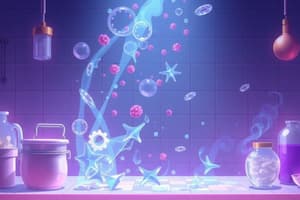Podcast
Questions and Answers
What temperature and pressure conditions are required for effective sterilization using an autoclave?
What temperature and pressure conditions are required for effective sterilization using an autoclave?
- 121°C and 2.0 bar
- 100°C and 1.0 bar
- 110°C and 1.5 bar
- 121°C and 1.2 bar (correct)
What is the limitation of using UV radiation for sterilization?
What is the limitation of using UV radiation for sterilization?
- It can penetrate through glass.
- It produces harmful gas when combined with water.
- It requires high temperatures to be effective.
- It has limited penetration in air. (correct)
Which chemical agent is recommended for sterilizing explants?
Which chemical agent is recommended for sterilizing explants?
- Sodium bicarbonate
- Ethanol 70% (correct)
- Hydrochloric acid
- Ammonium chloride
In the context of sterilization, which combination is harmful due to the release of chlorine gas?
In the context of sterilization, which combination is harmful due to the release of chlorine gas?
What is the primary purpose of using a glassware sterilizer in a laboratory?
What is the primary purpose of using a glassware sterilizer in a laboratory?
What kind of sterilization method is described as a sophisticated pressure cooker?
What kind of sterilization method is described as a sophisticated pressure cooker?
Which of the following agents is NOT listed as a chemical sterilizing agent?
Which of the following agents is NOT listed as a chemical sterilizing agent?
What can accumulate and potentially cause an explosion when using UV in closed laminar flow hoods?
What can accumulate and potentially cause an explosion when using UV in closed laminar flow hoods?
Flashcards
Sterilization
Sterilization
Utilizing heat to eliminate all forms of life, including bacteria, viruses, fungi, and spores.
Heat Sterilization
Heat Sterilization
The use of high temperatures to kill microorganisms, further classified as dry heat or wet heat methods.
Dry Heat Sterilization
Dry Heat Sterilization
The application of dry heat in an oven to sterilize objects. Often used for glassware and metal tools.
Wet Heat Sterilization
Wet Heat Sterilization
Signup and view all the flashcards
Radiation Sterilization
Radiation Sterilization
Signup and view all the flashcards
Autoclave
Autoclave
Signup and view all the flashcards
Hydrogen Peroxide (H2O2)
Hydrogen Peroxide (H2O2)
Signup and view all the flashcards
Ethanol 70%
Ethanol 70%
Signup and view all the flashcards
Study Notes
Sterilization Methods
- Sterilization is categorized into three main types: physical, chemical, and mechanical.
- Physical methods include heat, radiation, and mechanical methods.
- Chemical methods comprise various chemicals to sterilize explants.
- Mechanical methods involve filtration, a technique for heat-sensitive materials.
Physical Sterilization
-
Heat:
-
Dry heat: Utilizes an oven or flame; dry heat sterilizers range from 50-300°C. This method involves drying plant and metal tools to sterilize while causing protein coagulation, destroying microorganisms. It's used for glasswares and metal tools (160°C for 2h or 180°C for 1h).
-
Wet heat (moist): Accomplished through autoclaving and employs saturated steam under pressure. Standard autoclave settings are 121°C at 1.0 to 1.5 bar pressure. Time required depends on the volume of media (direct relationship). This is commonly used for media, glassware, plasticware, cotton plugs, and distilled water.
-
-
Radiation:
- UV: UV sterilizers provide limited penetration in the air, concentrating sterilization in a restricted area around the UV lamp. It's typically safe for small areas like laminar flow hoods. The combination of UV and sodium hypochlorite releases chlorine gas, which is harmful. Combining UV with a closed laminar flow hood can result in ozone buildup, causing explosions.
Chemical Sterilization
- Sterilization for explants: Uses various chemicals:
- Ethanol 70%: Dehydrates and coagulates microorganisms.
- H₂O₂: A safe method.
- Sodium hypochlorite: May cause chlorine gas release, so should be used cautiously.
- Silver nitrate (AgNO3): Be aware of this chemical's toxicity to embryos and seeds.
- Bromine water: A potential sterilizing chemical.
- HgCl₂: Used for underground stems and roots but requires multiple washes due to residual toxicity.
- Other chemicals mentioned include tap water, sterilized distilled water, and Tween 20 (to remove surface tension for efficient sterilization).
Mechanical Sterilization
- Filtration:
- Essential for heat-sensitive materials; particularly for ascorbic acid (AA) and growth regulators like IAA.
Studying That Suits You
Use AI to generate personalized quizzes and flashcards to suit your learning preferences.


